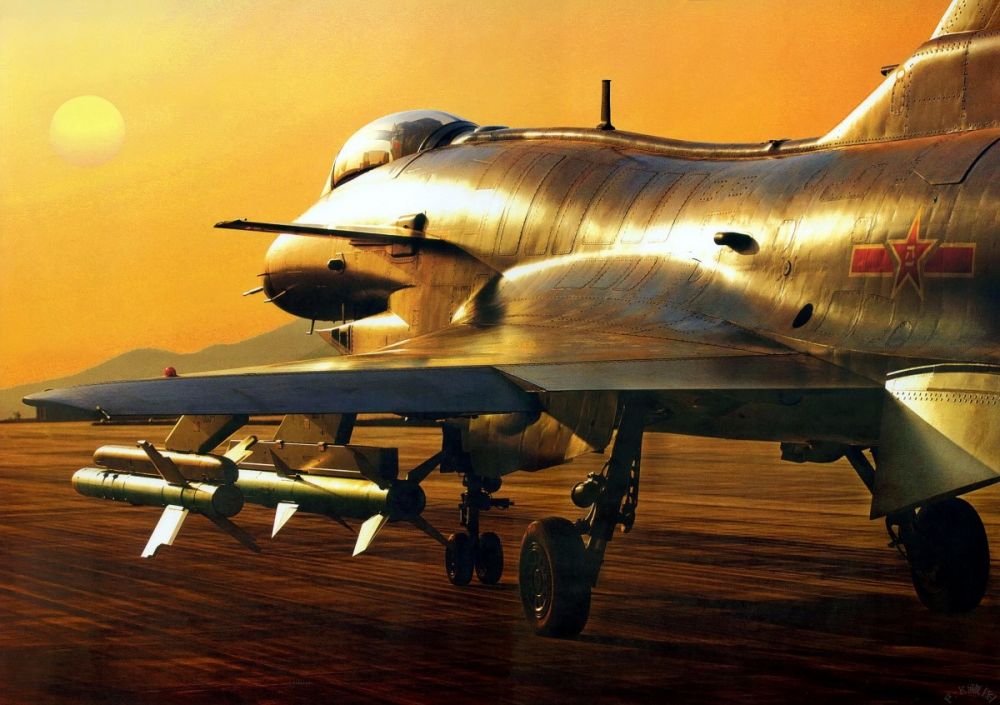How China Could Crush the U.S. Air Force in a Dog Fight
http://nationalinterest.org/blog/the-buzz/how-china-could-crush-the-us-air-force-dog-fight-22820
转载 自 美国 《国家利益》杂志

David Axe
http://nationalinterest.org/blog/the-buzz/how-china-could-crush-the-us-air-force-dog-fight-22820
转载 自 美国 《国家利益》杂志

David Axe
October 20, 2017
The new Chinese munition closely matches the dimensions
of Russia’s K-100 air-to-air missile, which has been in halting development for
25 years now but could, in theory, hit targets as far as 200 miles from the
launching plane.
of Russia’s K-100 air-to-air missile, which has been in halting development for
25 years now but could, in theory, hit targets as far as 200 miles from the
launching plane.
The Chinese military has apparently test-fired a
new?—?and potentially powerful?—?very-long-range air-to-air missile. If reports are accurate, the new weapon could hit U.S.
aircraft at twice the range at which the Americans can shoot back.
new?—?and potentially powerful?—?very-long-range air-to-air missile. If reports are accurate, the new weapon could hit U.S.
aircraft at twice the range at which the Americans can shoot back.
Images depicting the new missile under the wing of a
Chinese air force J-16 fighter circulated in November 2016. The J-16 reportedly
fired at least one of the missiles, successfully striking an aerial target.
Chinese air force J-16 fighter circulated in November 2016. The J-16 reportedly
fired at least one of the missiles, successfully striking an aerial target.
China has developed air-to-air missiles at a pace at least as rapid as its development of fighter aircraft.
The new very-long-range air-to-air missile, or VLRAAM, appeared suddenly. Foreign observers apparently
don’t even know what the Chinese call the new munition.
The new very-long-range air-to-air missile, or VLRAAM, appeared suddenly. Foreign observers apparently
don’t even know what the Chinese call the new munition.
Technical data on the missile is hard to come by, but the
photos Beijing has allowed to leak do at least establish the weapon’s
dimensions, which?—?along with a raft of publicly-available scientific
research?—?hint at the missile’s capabilities. In the photos, the VLRAAM is
clearly around a third the length of the J-16, giving the munition an overall
length of around 20 feet and a diameter of roughly a foot.
In any event, the weapon is much more substantial than is
the U.S. military’s own longest-range air-to-air missile, the AIM-120 Advanced
Medium-Range Air-to-Air Missile. The AMRAAM is just 12 feet long and seven
inches in diameter. The latest version of the
American missile, the AIM-120D (https://en.wikipedia.org/wiki/AIM-120_AMRAAM), reportedly boasts a maximum
range in excess of 90 miles (145 km).
photos Beijing has allowed to leak do at least establish the weapon’s
dimensions, which?—?along with a raft of publicly-available scientific
research?—?hint at the missile’s capabilities. In the photos, the VLRAAM is
clearly around a third the length of the J-16, giving the munition an overall
length of around 20 feet and a diameter of roughly a foot.
In any event, the weapon is much more substantial than is
the U.S. military’s own longest-range air-to-air missile, the AIM-120 Advanced
Medium-Range Air-to-Air Missile. The AMRAAM is just 12 feet long and seven
inches in diameter. The latest version of the
American missile, the AIM-120D (https://en.wikipedia.org/wiki/AIM-120_AMRAAM), reportedly boasts a maximum
range in excess of 90 miles (145 km).
The new Chinese munition closely matches the dimensions of Russia’s K-100
air-to-air missile, which has been in halting development for 25 years now but
could, in theory, hit targets as far as 200 miles from the launching plane.
air-to-air missile, which has been in halting development for 25 years now but
could, in theory, hit targets as far as 200 miles from the launching plane.
To achieve its apparent long range, the Chinese VLRAAM
reportedly relies on a powerful rocket motor than can propel the munition at
“hypersonic” speeds of up to Mach 6?—?half-again faster than the AIM-120D’s own
top speed (https://en.wikipedia.org/wiki/AIM-120_AMRAAM: Mach 4 (4,900 km/h; 3,045 mph).
reportedly relies on a powerful rocket motor than can propel the munition at
“hypersonic” speeds of up to Mach 6?—?half-again faster than the AIM-120D’s own
top speed (https://en.wikipedia.org/wiki/AIM-120_AMRAAM: Mach 4 (4,900 km/h; 3,045 mph).
Launched by a fighter flying as high as 50,000 feet, the Chinese missile could climb to
an altitude of around 100,000 feet and glide in the thin air for more than a
hundred miles before descending to strike its target?—?this according to recent studies in Chinese scientific
journals, which Popular Science helpfully pointed out.
an altitude of around 100,000 feet and glide in the thin air for more than a
hundred miles before descending to strike its target?—?this according to recent studies in Chinese scientific
journals, which Popular Science helpfully pointed out.
Moreover, Beijing’s VLRAAM reportedly features an active electronically-scanned array
seeker with optical back-up and mid-course satellite guidance?—?truly state of
the art for an air-to-air missile. The AIM-120D
makes do with an older-style, and less effective, mechanically-steered radar.
seeker with optical back-up and mid-course satellite guidance?—?truly state of
the art for an air-to-air missile. The AIM-120D
makes do with an older-style, and less effective, mechanically-steered radar.
Of course, a very-long-range missile is useless in the
absence of good targeting. Unless you’re willing to destroy every airplane
within reach?—?whether they’re enemy warplanes, civilian passenger jets or even
friendly forces?—?you need to identify opposing planes before attacking them.
absence of good targeting. Unless you’re willing to destroy every airplane
within reach?—?whether they’re enemy warplanes, civilian passenger jets or even
friendly forces?—?you need to identify opposing planes before attacking them.
The identification problem prevented the U.S. Navy from
successfully deploying its own AIM-54 Phoenix long-range air-to-air missile in
combat. The Navy retired the munition in 2004 in favor of cheaper and more
practical AMRAAMs.
successfully deploying its own AIM-54 Phoenix long-range air-to-air missile in
combat. The Navy retired the munition in 2004 in favor of cheaper and more
practical AMRAAMs.
The Chinese military is apparently working on a solution
to the identification problem, and has proposed building a targeting network
around the high-flying Divine Eagle sensor drone. A Divine Eagle could pass
targeting data to a VLRAAM-armed fighter?—?and potentially even to the missile
itself, provided any operational version of the munition incorporates a datalink.
to the identification problem, and has proposed building a targeting network
around the high-flying Divine Eagle sensor drone. A Divine Eagle could pass
targeting data to a VLRAAM-armed fighter?—?and potentially even to the missile
itself, provided any operational version of the munition incorporates a datalink.
In concept, China’s potential sensor-shooter network is
similar to the U.S. Navy’s own Naval Integrated Fire Control-Counter Air
network, which ties together various sensors platforms with fighters and ships
firing AMRAAMs and sea-launched air-defense missiles. NIFC-CA first deployed
with a carrier battle group in 2015.
similar to the U.S. Navy’s own Naval Integrated Fire Control-Counter Air
network, which ties together various sensors platforms with fighters and ships
firing AMRAAMs and sea-launched air-defense missiles. NIFC-CA first deployed
with a carrier battle group in 2015.
While making huge strides when it comes to targeting, the
U.S. military is falling behind in the advancement of air-launched munitions. The Pentagon has not yet begun developing a new long-range air-to-air missile to eventually replace the AIM-120D.
U.S. military is falling behind in the advancement of air-launched munitions. The Pentagon has not yet begun developing a new long-range air-to-air missile to eventually replace the AIM-120D.
The Americans have a years-long head-start fielding a
functional sensor-shooter network, but if the apparent November 2016
test-launch is any indication, the Chinese are way ahead when it comes to
far-flying munitions that can take advantage of such networks.
functional sensor-shooter network, but if the apparent November 2016
test-launch is any indication, the Chinese are way ahead when it comes to
far-flying munitions that can take advantage of such networks.
 选择“Disable on www.wenxuecity.com”
选择“Disable on www.wenxuecity.com”
 选择“don't run on pages on this domain”
选择“don't run on pages on this domain”

